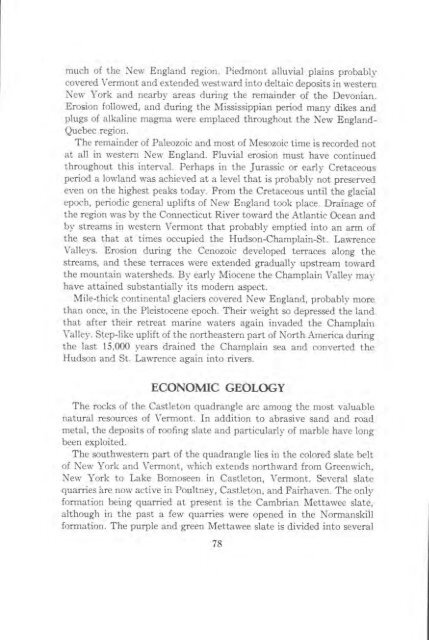STRATIGRAPHY AND STRUCTURE CASTLETON AREA VERMONT
STRATIGRAPHY AND STRUCTURE CASTLETON AREA VERMONT
STRATIGRAPHY AND STRUCTURE CASTLETON AREA VERMONT
You also want an ePaper? Increase the reach of your titles
YUMPU automatically turns print PDFs into web optimized ePapers that Google loves.
much of the New England region. Piedmont alluvial plains probably<br />
covered Vermont and extended westward into deltaic deposits in western<br />
New York and nearby areas during the remainder of the Devonian.<br />
Erosion followed, and during the Mississippian period many dikes and<br />
plugs of alkaline magma were emplaced throughout the New England-<br />
Quebec region.<br />
The remainder of Paleozoic and most of Mesozoic time is recorded not<br />
at all in western New England. Fluvial erosion must have continued<br />
throughout this interval. Perhaps in the Jurassic or early Cretaceous<br />
period a lowland was achieved at a level that is probably not preserved<br />
even on the highest peaks today. From the Cretaceous until the glacial<br />
epoch, periodic general uplifts of New England took place. Drainage of<br />
the region was by the Connecticut River toward the Atlantic Ocean and<br />
by streams in western Vermont that probably emptied into an arm of<br />
the sea that at times occupied the Hudson-Champlain-St. Lawrence<br />
Valleys. Erosion during the Cenozoic developed terraces along the<br />
streams, and these terraces were extended gradually upstream toward<br />
the mountain watersheds. By early Miocene the Champlain Valley may<br />
have attained substantially its modern aspect.<br />
Mile-thick continental glaciers covered New England, probably more<br />
than once, in the Pleistocene epoch. Their weight so depressed the land<br />
that after their retreat marine waters again invaded the Champlain<br />
Valley. Step-like uplift of the northeastern part of North America during<br />
the last 15,000 years drained the Champlain sea and converted the<br />
Hudson and St. Lawrence again into rivers.<br />
ECONOMIC GEOLOGY<br />
The rocks of the Castleton quadrangle are among the most valuable<br />
natural resources of Vermont. In addition to abrasive sand and road<br />
metal, the deposits of roofing slate and particularly of marble have long<br />
been exploited.<br />
The southwestern part of the quadrangle lies in the colored slate belt<br />
of New York and Vermont, which extends northward from Greenwich,<br />
New York to Lake Bomoseen in Castleton, Vermont. Several slate<br />
quarries are now active in Poultney, Castleton, and Fairhaven. The only<br />
formation being quarried at present is the Cambrian Mettawee slate,<br />
although in the past a few quarries were opened in the Normanskill<br />
formation. The purple and green Mettawee slate is divided into several<br />
78













